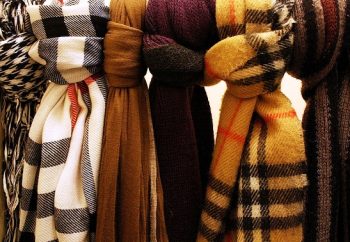Hebrew Winter Clothing: How to Use the Hebrew Word for Scarf Posted by Ayana on Feb 19, 2018 in Uncategorized
Stylish winter clothing can illuminate any bleak cold day. Scarves, for instance, not only keep your neck warm, but also upgrade your outfit. An elegant way to wear a dull jacket or a simple cardigan, for example, is to wrap a chic scarf around your neck. On winter days or autumn evenings, Israeli boys and girls keep warm and fashionable with scarves.
The Hebrew word for scarf is a two-syllable word – צָעִיף. The first syllable is צָ (pronounced as ‛tza’), and the second is עִיף (pronounced as ‛if’). צָעִיף is a masculine noun (as indicated by its ending with consonant). The demonstrative pronoun that refers to צָעִיף is masculine as well – זֶה. For example:
זֶה צָעִיף נֶחְמָד.
This is a nice scarf.
זֶה צָעִיף יָפֶה, אֲבָל הוּא קְצָת יָקָר.
This is beautiful scarf, but a bit expensive.
Watch this video and listen to the correct pronunciation of the word צָעִיף:
All Semitic verbs are being conjugated. In Hebrew (and other Semitic languages), not only verbs, but every word can be changed according to the tense, gender, number and attribution. An adjective will be different in respective to the gender of the noun it’s describing. צָעִיף is a masculine noun, and therefore all the adjectives to describe צָעִיף will be in their masculine form as well. For example:
Long scarf = צָעִיף אָרֹוךְ
Colorful scarf = צָעִיף צִבְעוֹנִי
Beautiful scarf = צָעִיף יָפֶה
Blue scarf = צָעִיף כָּחֹול
Thick scarf = צָעִיף עָבֶה
אַתָּה מְחַפֵּשׂ צָעִיף אָרֹוךְ אוֺ צָעִיף עָבֶה?
Are you looking for a long scarf or a thick scarf?
צָעִיף יָפֶה זֶה מַתָּנָה נֶחְמָדָה.
A beautiful scarf is a nice gift.
A Hebrew adjective will be also changed according to the number of the noun it’s describing – singular or plural. צָעִיף’s plural form is צְעִיפׅים (pronounced as tze-yi-fim). The vowel of the first syllable had changed from צָ (‛tza’) to צְ (‛tze’) in the plural form; and the last vowel became ׅים (‛im’), instead of ִיף (‛if’). A suffix will be added to an adjective if it describe scarves and not a scarf. Adjectives that describe scarves should be masculine, of course, but in their plural form. For example:
Long scarves = צְעִיפׅים אֲרוּכּׅים
Colorful scarves = צְעִיפׅים צִבְעוֹנִיּׅים
Beautiful scarves = צְעִיפׅים יָפׅים
Blue scarves = צְעִיפׅים כְּחוּלׅים
Thick scarves = צְעִיפׅים עָבׅים
בָּאָרוֺן יֵשׁ צְעִיפׅים יָפׅים.
There are beautiful scarves in the closet.
אֲנׅי אוֺהֵב גַּם צְעִיפׅים צִבְעוֹנִיּׅים וְגַם צְעִיפׅים כְּחוּלׅים.
I love colorful scarves and blue scarves too.
When talking about specific scarf or scarves, we need to use the definite article hey hayedia. The prefix ה functions like the article ‛the’ in English, and makes the noun definite. For example:
הַצָּעִיף נִמְצָא בַּחֶדֶר שֶׁלׅי.
The scarf is in my room.
זֶה הַצָּעִיף שֶׁלׅי, וְזֶה הַצָּעִיף שֶׁלָהּ.
This is my scarf, and this is hers.
הַצְּעִיפׅים בַּחֲנוּת הַזֺּאת מְאוֺד יְקָרׅים.
The scarves in this store are very expensive.
If the definite noun is described by an adjective, the adjective should be made definite too. In English, we don’t repeat the definite word ‛the’ twice – one for the noun and one for the adjective, but in Hebrew we do. We repeat the prefix ה before the noun, and also before the adjective that follows. For example:
הַצָּעִיף הַכָּחֹול הֲכׅי יָפֶה.
The blue scarf is the most beautiful.
הַצְּעִיפׅים הֶעָבׅים מְחַמֵּמׅים הֵיטֵב.
The thick scarves warm better.
After we choose a scarf – זֶה הַצָּעִיף שֶׁאֲנׅי רוֺצֶה (this is the scarf I want); or buy a scarf זֶה הַצָּעִיף שֶׁקָּנׅיתׅי (this is the scarf I bought) – it’s time to put it on. There are three verbs to use with scarves: לׅלְבּוֺשׁ (to wear), לָשׂׅים (to put), and לֲעֲטוֺת (to wrap). לֲעֲטוֺת (to wrap) is less common. You can definitely use it, but it considered more literary language.
הוּא עָטָה עַל עַצְמוֺ צָעִיף וְיָצָא הַחוּצָה.
He wrapped a scarf and went out.
לָשׂׅים (to put) is much more common in spoken Hebrew. But לָשׂׅים is colloquial, and some scholars and teachers strongly object to the use of this verb when referring to clothes. They believe the use of a general verb that can be attribute to any object – put your bag in its place, I put your book on the table, please put the ball down – is less adequate when talking about clothing. If you are not strict as them you can use the verb לָשׂׅים referring to your scarf.
מוֺצֵא חֵן בְּעֵינַי הַצָּעִיף שֶׁשַּׂמְתָּ הַיּוֺם.
I like the scarf you put on today.
קָדִימָה, שׂׅים צָעִיף וְלֺא לׅשְׁכּוֺחַ כּוֹבַע.
Hurry on, put your scarf and don’t forget hat.
לׅלְבּוֺשׁ (to wear) is the regular verb for clothing. You can use it with any piece of wearing: shirt, pants, coat, dress; and scarf as well.
אֲנׅי חַיָּיב לׅלְבּוֺשׁ צָעִיף, אַחֶרֶת הַצַּוָּואר שֶׁלּׅי קוֺפֵא.
I must wear a scarf, otherwise my neck freezes.
אַף פַּעַם לֺא רָאׅיתׅי אוֺתְךָ לוֺבֵשׁ אֶת אוֺתוֺ צָעִיף פַּעֲמַיׅים.
I never you saw wearing the same scarf twice.
Now that you have learned how to properly use the Hebrew word for scarf, it’s time to learn how to wear the scarf itself in Hebrew:
https://www.youtube.com/watch?v=jtRIEV-uRMc
Few other ways to wear your scarf:
Related posts:
Summer, Autumn, Winter, Spring: The Four Seasons in Hebrew
Keep Calm and Learn Hebrew

Build vocabulary, practice pronunciation, and more with Transparent Language Online. Available anytime, anywhere, on any device.




